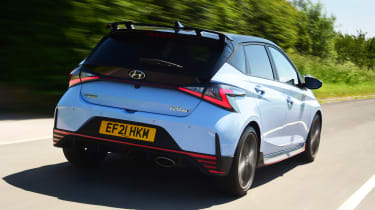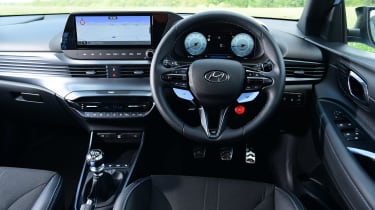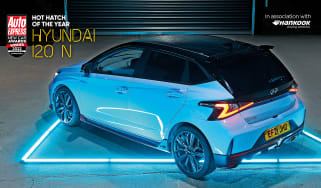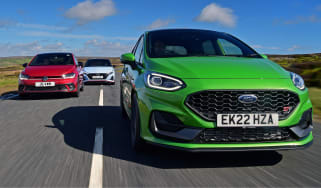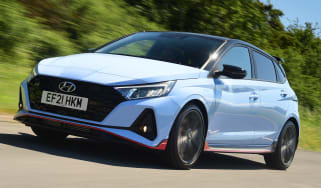New Hyundai i20 N 2021 review
We get behind the wheel of the new 201bhp Hyundai i20 N hot hatch

Verdict
The i20 N marks another impressive step for Hyundai’s performance division, mixing a fun chassis set-up with strong performance. It’s close to landing a knockout blow on the Fiesta ST on driving dynamics, but in its own way it matches the Ford for charm – and then goes on to outscore it on other attributes like space, standard kit and value for money. We’d say that makes it a pretty stellar hot supermini overall.
Hyundai is a brand casting a wide net at the moment. The Korean firm is getting really serious about its electric Ioniq sub-brand, but at the same time it’s still trying to establish N as a performance division.
It’s been making solid progress in both areas; the i30 N was a decent first effort as a hot hatch, and we were impressed by its smaller stablemate, the i20 N, when we tried it in left-hand-drive form earlier this year. Now we’ve had a chance to drive the finished right-hand-drive car on UK roads.
While the i30 N was conceived and developed after the base model had been launched, the Fiesta ST rival was stitched into the original design of this generation of i20. That meant input from day one from Albert Biermann, the former head of BMW’s M division who is now responsible for all of Hyundai’s vehicle dynamics. How has his team used this starting point? Rather well, it turns out. On paper at least, the i20 N has all the ingredients of a great small hot hatch.
More reviews
Car group tests
- Vauxhall Corsa vs Hyundai i20: supermini titans go head-to-head
- Ford Fiesta ST vs Volkswagen Polo GTI vs Hyundai i20 N: 2022 group test review
- Volkswagen Polo vs SEAT Ibiza vs Hyundai i20: 2021 group test review
In-depth reviews
Road tests
- New Hyundai i20 facelift 2023 review: subtle updates for an already stylish supermini
- New Hyundai i20 N Line 2022 review
Used car tests
There’s a four-cylinder turbocharged petrol engine producing 201bhp and 275Nm of torque – enough for a 0-62mph time of 6.2 seconds and a top speed of 142mph. The transmission is a six-speed manual, equipped with a rev-matching function in case you don’t want to heel and toe yourself, and there’s also a mechanical limited-slip differential. The suspension is revised too, with sturdier knuckles at the front end and a beefed-up torsion beam at the rear. There’s more bracing across the chassis, in fact, and revised springs and dampers, plus more negative camber.
The new i20’s styling also gets a sharper focus too, with different bumpers that help to widen the car’s stance, and a prominent rear spoiler. Side skirts and 18-inch alloys complete a dramatic look, especially if the car is finished in N’s trademark blue paint.
Inside, there’s a couple of bucket seats that aren’t quite as supportive as you might want, but plenty of useful tech, including a standard 10.25-inch digital instrument panel, a touchscreen infotainment system that’s among the best in the class, wireless phone charging, a reversing camera with parking sensors, and climate control. It’s fully laden, then – but as in the regular i20, the finish of the materials is a bit hit and miss.
At least it’s spacious, with 352 litres of boot capacity and rear seats that adults won’t complain about too much. It’s offered only with a five-door body, too, so access to the second row is easy enough.
But it’s on the road where the i20 N really has to deliver, and the good news is that Hyundai has produced a compelling offering. It has a slightly different mix of qualities to the Fiesta ST, perhaps, but this is still a car with real enthusiast appeal.
The engine produces its maximum torque across a decent spread, between 1,750rpm and 4,500rpm, and you’ll enjoy revving the unit out. It’s not the most characterful tone, and the artificial enhancement doesn’t improve matters, but there are at least little rally car-style gargles as you lift off the throttle.
That flexibility means you don’t have to flick between gears all the time, but if you do choose to do so, you’ll find the shift light and precise. And the rev-matching function – activated via modes that can be selected and customised on a pair of steering wheel buttons – does precisely what this sort of system should, by making you feel a true hero instead of a bit of a cheat.
The real star of the show, though, is the chassis. The front end has a colossal level of grip, giving you the confidence to carry prodigious speed into corners. That clever differential’s impact also gives a little boost to the nose’s response as you apply power mid-corner. And yes, there is a little bit of torque steer on cambered roads, but it’s mild. The overall impression is of a diff that’s been tuned to provide assistance with little trade-off.
The suspension has been set up according to the same principles, it would seem. You know you’re in a performance car, but on bumpier back roads the i20 shows admirable compliance at lower speeds that evolves into fine body control on the faster stuff.
Overall, the hot i20 feels every bit as fun as a 1,200kg car with 201bhp should. It’s more civilised than the i30 N, yet more enjoyable. We’d like a bit more feel through the steering, admittedly, but it’s quick and direct enough for you to throw inputs at the chassis – which, in turn, gives you feedback about what’s happening at each wheel.
Across the board, then, there’s not much to split the i20 N and the Fiesta. But spec the Ford to the same level and it’ll cost almost £1,000 more – and while the gap will undoubtedly ebb and flow if dealers play with discounts and deposit contributions, even on standard PCP terms the Hyundai will be about £250 cheaper over three years.
| Model | Hyundai i20 N |
| Price: | £24,995 |
| Engine: | 1.6-litre 4cyl turbo petrol |
| Power/torque: | 201bhp/275Nm |
| Transmission: | Six-speed manual, front-wheel drive |
| 0-62mph: | 6.2 seconds |
| Top speed: | 142mph |
| Economy: | 40.4mpg |
| CO2: | 158g/km |
| On sale: | Now |



